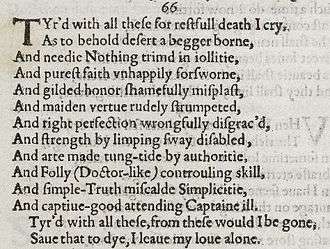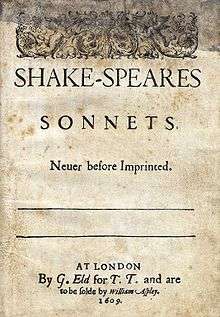Sonnet 66
Sonnet 66 is one of 154 sonnets written by the English playwright and poet William Shakespeare. It's a member of the Fair Youth sequence, in which the poet expresses his love towards a young man.
| Sonnet 66 | |||||||
|---|---|---|---|---|---|---|---|
 Sonnet 66 in the 1609 Quarto | |||||||
| |||||||
Synopsis
Sonnet 66 is a world-weary, desperate list of grievances of the state of the poet's society. The speaker criticizes three things: general unfairness of life, societal immorality, and oppressive government. Lines 2 and 3 illustrate the economic unfairness caused by one's station or nobility:
As, to behold desert a beggar born,
And needy nothing trimm'd in jollity, (66.2-3)
Lines 4-7 portray disgraced trust and loyalty, unfairly given authority, as by an unworthy king "gilded honour shamefully misplaced", and female innocence corrupted "Maiden virtue rudely strumpeted". Lines 8, 10, and 12, as in lines 2 and 3, characterize reversals of what one deserves, and what one actually receives in life.
As opposed to most of his sonnets, which have a "turn" in mood or thought at line 9, (the beginning of the third quatrain (See: Sonnets 29, 18) the mood of Sonnet 66 does not change until the last line, when the speaker declares that the only thing keeping him alive is his lover. This stresses the fact that his lover is helping him merely survive, whereas sonnets 29 and 30 are much more positive and have 6 lines in which they affirm that the lover is the fulfillment of the poet's life.
Structure
Sonnet 66 is an English or Shakespearean sonnet. The English sonnet has three quatrains, followed by a final rhyming couplet. It follows the typical rhyme scheme of the form, ABAB CDCD EFEF GG, and is composed in iambic pentameter, a type of poetic metre based on five pairs of metrically weak/strong syllabic positions. The tenth line exemplifies a regular iambic pentameter:
× / × / × / × / × / And folly doctor-like controlling skill, (66.10)
- / = ictus, a metrically strong syllabic position. × = nonictus.
This line and its rhyme-mate, line 12, happen to have a fully stressed syllable for each ictus; all the other regular lines have one unstressed syllable taking the ictus (for example the final syllables of line four's "unhappily" and line eight's four-syllable "disabled"). These highly-patterned lines are bookended by four lines — two at the beginning and two at the end — with an initial reversal, as in line one:
/ × × / × / × / × / Tired with all these, for restful death I cry, (66.1)
Interpretations and adaptations
Dmitri Shostakovich set Boris Pasternak's Russian translation of this sonnet to music as part of his 1942 song cycle Six Romances on Verses by English Poets (Op. 62). Because Pasternak's translation is also in iambic pentameter, the piece can be, and sometimes is, performed with Shakespeare's original words instead (for example, by Gerald Finley on his 2014 album of Shostakovich songs for Ondine). The critic Ian MacDonald suggested that Shostakovich may have used this sonnet, with its reference to "art made tongue-tied by authority," as an oblique commentary on his own oppression by the Soviet state;[2] however, the scholar Elizabeth Wilson pointed out that Pasternak's translation "somewhat watered down" the original's meaning, with his version of that line translating as "And remember that thoughts will close up the mouth." [3]
Alan Bates performed this sonnet for the 2002 compilation album, When Love Speaks (EMI Classics).
Notes
- Pooler, C[harles] Knox, ed. (1918). The Works of Shakespeare: Sonnets. The Arden Shakespeare [1st series]. London: Methuen & Company. OCLC 4770201.
- MacDonald, Ian (2006). The New Shostakovich (Revised ed.). London: Pimlico. p. 189. ISBN 1-845-95064-X.
- Wilson, Elizabeth (2006). Shostakovich: A Life Remembered (Second ed.). Princeton and Oxford: Princeton University Press. p. 179. ISBN 0-691-12886-3.
References
- First edition and facsimile
- Shakespeare, William (1609). Shake-speares Sonnets: Never Before Imprinted. London: Thomas Thorpe.CS1 maint: ref=harv (link)
- Lee, Sidney, ed. (1905). Shakespeares Sonnets: Being a reproduction in facsimile of the first edition. Oxford: Clarendon Press. OCLC 458829162.
- Variorum editions
- Alden, Raymond Macdonald, ed. (1916). The Sonnets of Shakespeare. Boston: Houghton Mifflin Company. OCLC 234756.
- Rollins, Hyder Edward, ed. (1944). A New Variorum Edition of Shakespeare: The Sonnets [2 Volumes]. Philadelphia: J. B. Lippincott & Co. OCLC 6028485.
- Modern critical editions
- Atkins, Carl D., ed. (2007). Shakespeare's Sonnets: With Three Hundred Years of Commentary. Madison: Fairleigh Dickinson University Press. ISBN 978-0-8386-4163-7. OCLC 86090499.
- Booth, Stephen, ed. (2000) [1st ed. 1977]. Shakespeare's Sonnets (Rev. ed.). New Haven: Yale Nota Bene. ISBN 0-300-01959-9. OCLC 2968040.
- Burrow, Colin, ed. (2002). The Complete Sonnets and Poems. The Oxford Shakespeare. Oxford: Oxford University Press. ISBN 978-0192819338. OCLC 48532938.
- Duncan-Jones, Katherine, ed. (2010) [1st ed. 1997]. Shakespeare's Sonnets. The Arden Shakespeare, Third Series (Rev. ed.). London: Bloomsbury. ISBN 978-1-4080-1797-5. OCLC 755065951.
- Evans, G. Blakemore, ed. (1996). The Sonnets. The New Cambridge Shakespeare. Cambridge: Cambridge University Press. ISBN 978-0521294034. OCLC 32272082.
- Kerrigan, John, ed. (1995) [1st ed. 1986]. The Sonnets ; and, A Lover's Complaint. New Penguin Shakespeare (Rev. ed.). Penguin Books. ISBN 0-14-070732-8. OCLC 15018446.
- Mowat, Barbara A.; Werstine, Paul, eds. (2006). Shakespeare's Sonnets & Poems. Folger Shakespeare Library. New York: Washington Square Press. ISBN 978-0743273282. OCLC 64594469.
- Orgel, Stephen, ed. (2001). The Sonnets. The Pelican Shakespeare (Rev. ed.). New York: Penguin Books. ISBN 978-0140714531. OCLC 46683809.
- Vendler, Helen, ed. (1997). The Art of Shakespeare's Sonnets. Cambridge, MA: The Belknap Press of Harvard University Press. ISBN 0-674-63712-7. OCLC 36806589.
.png)
